How to Design Tests
Please open notebook rsepython-s2r2.ipynb
Equivalence partitioning
Think hard about the different cases the code will run under: this is science, not coding!
We can’t write a test for every possible input: this is an infinite amount of work.
We need to write tests to rule out different bugs. There’s no need to separately test equivalent inputs.
Let’s look at an example of this question outside of coding:
- Research Project : Evolution of agricultural fields in Saskatchewan from aerial photography
- In silico translation : Compute overlap of two rectangles
import matplotlib.pyplot as plt
from matplotlib.path import Path
import matplotlib.patches as patches
%matplotlib inline
Let’s make a little fragment of matplotlib code to visualise a pair of fields.
def show_fields(field1, field2):
def vertices(left, bottom, right, top):
verts = [(left, bottom),
(left, top),
(right, top),
(right, bottom),
(left, bottom)]
return verts
codes = [Path.MOVETO,
Path.LINETO,
Path.LINETO,
Path.LINETO,
Path.CLOSEPOLY]
path1 = Path(vertices(*field1), codes)
path2 = Path(vertices(*field2), codes)
fig = plt.figure()
ax = fig.add_subplot(111)
patch1 = patches.PathPatch(path1, facecolor='orange', lw=2)
patch2 = patches.PathPatch(path2, facecolor='blue', lw=2)
ax.add_patch(patch1)
ax.add_patch(patch2)
ax.set_xlim(0,5)
ax.set_ylim(0,5)
show_fields((1.,1.,4.,4.),(2.,2.,3.,3.))
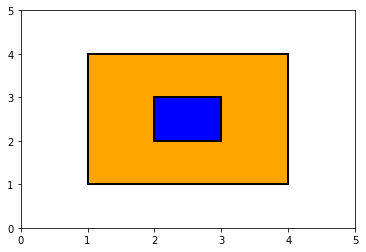
Here, we can see that the area of overlap, is the same as the smaller field, with area 1.
We could now go ahead and write a subroutine to calculate that, and also write some test cases for our answer.
But first, let’s just consider that question abstractly, what other cases, not equivalent to this might there be?
For example, this case, is still just a full overlap, and is sufficiently equivalent that it’s not worth another test:
show_fields((1.,1.,4.,4.),(2.5,1.7,3.2,3.4))
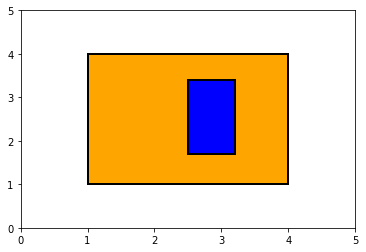
But this case is no longer a full overlap, and should be tested separately:
show_fields((1.,1.,4.,4.),(2.,2.,3.,4.5))
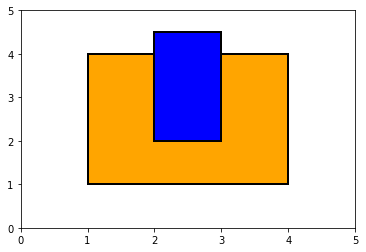
On a piece of paper, sketch now the other cases you think should be treated as non-equivalent. Some answers are below:
for _ in range(10):
print("Spoiler space\n")
Spoiler space
Spoiler space
Spoiler space
Spoiler space
Spoiler space
Spoiler space
Spoiler space
Spoiler space
Spoiler space
Spoiler space
show_fields((1.,1.,4.,4.),(2,2,4.5,4.5)) # Overlap corner
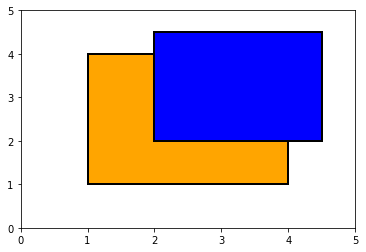
show_fields((1.,1.,4.,4.),(2.,2.,3.,4.)) # Just touching
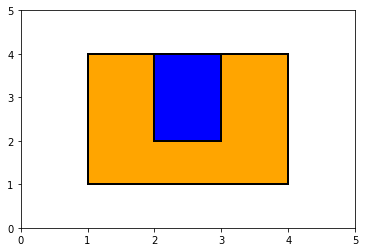
show_fields((1.,1.,4.,4.),(4.5,4.5,5,5)) # No overlap
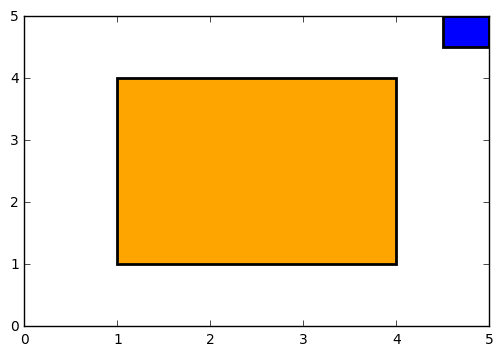
show_fields((1.,1.,4.,4.),(2.5,4,3.5,4.5)) # Just touching from outside
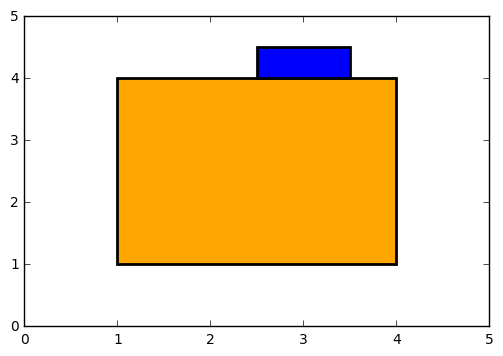
show_fields((1.,1.,4.,4.),(4,4,4.5,4.5)) # Touching corner
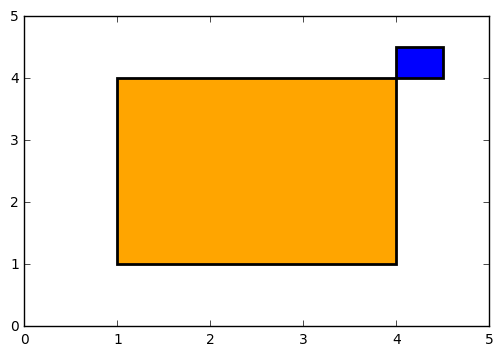
Using our tests
OK, so how might our tests be useful?
Here’s some code that might correctly calculate the area of overlap:
def overlap(field1, field2):
left1, bottom1, top1, right1 = field1
left2, bottom2, top2, right2 = field2
overlap_left=max(left1, left2)
overlap_bottom=max(bottom1, bottom2)
overlap_right=min(right1, right2)
overlap_top=min(top1, top2)
overlap_height=(overlap_top-overlap_bottom)
overlap_width=(overlap_right-overlap_left)
return overlap_height*overlap_width
So how do we check our code?
The manual approach would be to look at some cases, and, once, run it and check:
overlap((1.,1.,4.,4.),(2.,2.,3.,3.))
1.0
That looks OK.
But we can do better, we can write code which raises an error if it gets an unexpected answer:
assert overlap((1.,1.,4.,4.),(2.,2.,3.,3.)) == 1.0
assert overlap((1.,1.,4.,4.),(2.,2.,3.,4.5)) == 2.0
assert overlap((1.,1.,4.,4.),(2.,2.,4.5,4.5)) == 4.0
assert overlap((1.,1.,4.,4.),(4.5,4.5,5,5)) == 0.0
—————————————————————————
AssertionError Traceback (most recent call last)
—-> 1 assert overlap((1.,1.,4.,4.),(4.5,4.5,5,5)) == 0.0
AssertionError:
print(overlap((1.,1.,4.,4.),(4.5,4.5,5,5)))
0.25
show_fields((1.,1.,4.,4.),(4.5,4.5,5,5))
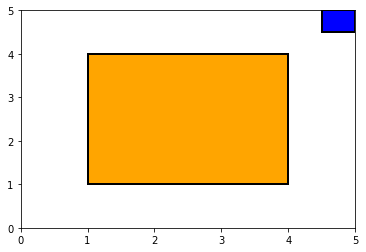
What? Why is this wrong?
In our calculation, we are actually getting:
overlap_left = 4.5
overlap_right = 4
overlap_width = -0.5
overlap_height = -0.5
Both width and height are negative, resulting in a positive area. The above code didn’t take into account the non-overlap correctly.
It should be:
def overlap(field1, field2):
left1, bottom1, top1, right1 = field1
left2, bottom2, top2, right2 = field2
overlap_left=max(left1, left2)
overlap_bottom=max(bottom1, bottom2)
overlap_right=min(right1, right2)
overlap_top=min(top1, top2)
overlap_height=max(0, (overlap_top-overlap_bottom))
overlap_width=max(0, (overlap_right-overlap_left))
return overlap_height*overlap_width
assert overlap((1,1,4,4),(2,2,3,3)) == 1.0
assert overlap((1,1,4,4),(2,2,3,4.5)) == 2.0
assert overlap((1,1,4,4),(2,2,4.5,4.5)) == 4.0
assert overlap((1,1,4,4),(4.5,4.5,5,5)) == 0.0
assert overlap((1,1,4,4),(2.5,4,3.5,4.5)) == 0.0
assert overlap((1,1,4,4),(4,4,4.5,4.5)) == 0.0
Note, we re-ran our other tests, to check our fix didn’t break something else. (We call that “fallout”).
Boundary cases
“Boundary cases” are an important area to test:
- Limit between two equivalence classes: edge and corner sharing fields
- Wherever indices appear, check values at
0,N,N+1 - Empty arrays:
atoms = [read_input_atom(input_atom) for input_atom in input_file]
energy = force_field(atoms)
- What happens if
atomsis an empty list? - What happens when a matrix/data-frame reaches one row, or one column?
Positive and negative tests
- Positive tests: code should give correct answer with various inputs
- Negative tests: code should crash as expected given invalid inputs, rather than lying
Raising exceptions
In Python, we can signal an error state by raising an exception:
def I_only_accept_positive_numbers(number):
# Check input
if number < 0:
raise ValueError("Input "+ str(number)+" is negative")
# Do something
I_only_accept_positive_numbers(5)
I_only_accept_positive_numbers(-5)
—————————————————————————
ValueError Traceback (most recent call last)
—-> 1 I_only_accept_positive_numbers(-5)
2 # Check input
3 if number < 0:
—-> 4 raise ValueError(“Input “+ str(number)+” is negative”)
5
6 # Do something
ValueError: Input -5 is negative
There are standard “Exception” types, like ValueError we can raise.
To find out more about the in-built Python exceptions visit: https://docs.python.org/3/library/exceptions.html.
We would like to be able to write tests like this:
assert I_only_accept_positive_numbers(-5) == # Gives a value error
File “
assert I_only_accept_positive_numbers(-5) == # Gives a value error
^
SyntaxError: invalid syntax
But to do that, we need to learn about more sophisticated testing tools, called “test frameworks”.
Next: Reading - PyTest